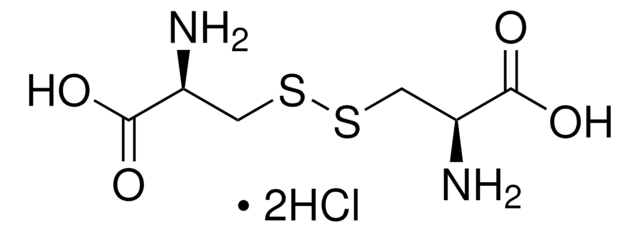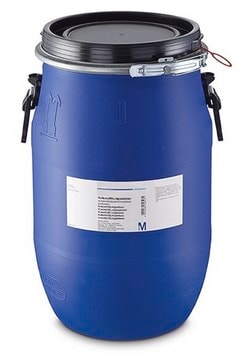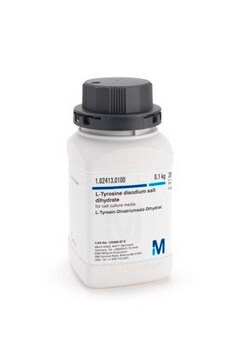Key Documents
C6727
L-Cystine dihydrochloride
≥98.0% dry basis, suitable for cell culture, BioReagent, non-animal source
Synonim(y):
Cystine dihydrochloride
About This Item
Polecane produkty
product name
L-Cystine dihydrochloride, from non-animal source, BioReagent, suitable for cell culture, ≥98.0% dry basis
pochodzenie biologiczne
non-animal source
Poziom jakości
linia produktu
BioReagent
Próba
≥98.0% dry basis
Postać
powder or crystals
aktywność optyczna
[α]20/D -174 to -164 °, c = 2 in 1 M HCl
metody
cell culture | mammalian: suitable
zanieczyszczenia
endotoxin, tested
kolor
white to off-white
mp
≥211.36 °C
rozpuszczalność
2 M HCl: 50 mg/mL
ślady kationów
As: ≤2 ppm
Fe: ≤30 ppm
NH4+: ≤0.03%
heavy metals: ≤10 ppm
grupa funkcyjna
carboxylic acid
thiol
temp. przechowywania
room temp
ciąg SMILES
Cl.Cl.N[C@@H](CSSC[C@H](N)C(O)=O)C(O)=O
InChI
1S/C6H12N2O4S2.2ClH/c7-3(5(9)10)1-13-14-2-4(8)6(11)12;;/h3-4H,1-2,7-8H2,(H,9,10)(H,11,12);2*1H/t3-,4-;;/m0../s1
Klucz InChI
HHGZUQPEIHGQST-RGVONZFCSA-N
Szukasz podobnych produktów? Odwiedź Przewodnik dotyczący porównywania produktów
Powiązane kategorie
Opis ogólny
Zastosowanie
- as a supplement to study homopropargylglycine update in metabolomics
- as a supplement in protein synthesis for cell biology and stem cell research
- to study the effect of lipid peroxidation and ferroptosis by regulation of cysteine and GSH levels in biochemical research
Działania biochem./fizjol.
Cechy i korzyści
- High-quality compound suitable for multiple research applications
- Suitable for mammalian cell culture
- Prepared from non-animal source
- Tested for Endotoxins
Przestroga
Inne uwagi
produkt podobny
Hasło ostrzegawcze
Danger
Zwroty wskazujące rodzaj zagrożenia
Zwroty wskazujące środki ostrożności
Klasyfikacja zagrożeń
Eye Dam. 1 - Skin Corr. 1B
Kod klasy składowania
8A - Combustible corrosive hazardous materials
Klasa zagrożenia wodnego (WGK)
WGK 1
Temperatura zapłonu (°F)
Not applicable
Temperatura zapłonu (°C)
Not applicable
Środki ochrony indywidualnej
Eyeshields, Gloves, type N95 (US)
Certyfikaty analizy (CoA)
Poszukaj Certyfikaty analizy (CoA), wpisując numer partii/serii produktów. Numery serii i partii można znaleźć na etykiecie produktu po słowach „seria” lub „partia”.
Masz już ten produkt?
Dokumenty związane z niedawno zakupionymi produktami zostały zamieszczone w Bibliotece dokumentów.
Klienci oglądali również te produkty
Produkty
Znaczenie i zastosowanie cysteiny w hodowlach eukariotycznych bez surowicy, w tym hybrydoma i komórki jajnika chomika chińskiego (CHO)
Nasz zespół naukowców ma doświadczenie we wszystkich obszarach badań, w tym w naukach przyrodniczych, materiałoznawstwie, syntezie chemicznej, chromatografii, analityce i wielu innych dziedzinach.
Skontaktuj się z zespołem ds. pomocy technicznej











